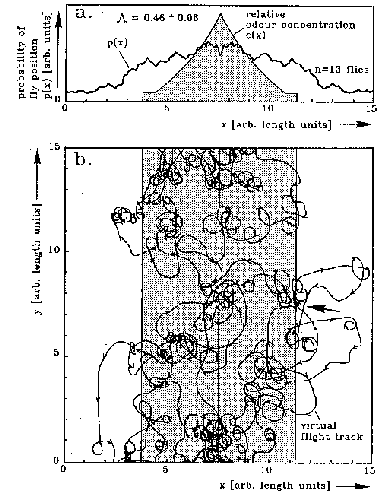Yaw Torque Operates an Attractive Odor
In this paradigm, the fly is tethered in the Drosophila flight simulator in a totally dark environment. An artificial flight path in a virtual horizontal plane is continuosly calculated: due to the high air friction and small rotational moment of inertia, angular velocity in free flight is taken to be proportional to the fly's yaw torque. The time integral of the momentarily recorded yaw torque, therefore, is proportional to the angular direction of flight. Assuming, for technical reasons, a constant flight velocity, the on-line calculation gives the x-y-coordinates of the fly's actual postion on an imaginary two-dimensional space. As reinforcer serves an attractive odor of fermenting banana, applied as a constant stream of air from the front. The computer divides the virtual plane into alternating fields of scented air in which the odor concentration is controlled as shown in Fig. a. The flies spend more time inside the odor-fields than outside and tend to navigate towards the boundaries between scented and odor free zones. Since the arena is not illuminated and hence no optical information is available for the fly, it has to compare efference copies of its yaw torque modulations with the temporal pattern of chemorezeptor signals. It is not known, however, how they accomplish their task. It is doubtful whether Drosophila is able to derive a two dimensional plane from its yaw torque modulations and a temporal pattern of odor plumes. More likely, the flies use the simple rule of increasing the absolute value of yaw torque whenever inside the odor-plume, making the path more twisted and increasing the time spent there.
Drosophila modulates its yaw torque in order to stay in an odour plume. The fly is suspended at the torque compensator in total darkness. A steady stream of air which can be scented by the odour of fermenting banana is directed at the fly from the front. The continuous yaw torque signal of the fly is used to calculate an artificial flight track in an infinite 2-dimensional space. The calculation is based upon the parameters used in the standard conditions of the Drosophila flight simulator in which yaw torque is made proportional to angular velocity (coupling constant: k= 5.5°/ 10-10 Nms). Forward velocity is assumed to be constant and is set to I arbitrary length unit (ALU) per second. Along the direction of the x-coordinate the artificial space is divided into infinitely long stripes of equal width (7.5 ALUs). Every second one is an artificial odour plume (shaded area). Its profile of odour concentration c(x) is shown in (a). It is generated by making the odour concentration in the air stream dependent upon the fly's calculated position in the artificial space. In (b) a continuous 15-min flight track of a single fly is plotted. For this purpose the 2D-space is divided into squares of 15 x 15 ALUs. In the figure all squares are superimposed upon each other; i.e. if the fly leaves one square at the top it will enter the next one at the bottom. The start of the experiment is located at the odour/no-odour boundary (o). The cumulated positions of 13 flies (15 min each) along the x-axis (p(x)) is given in (a). The performance index lambda = 0.46+-0.06 (SEM) indicates that in the average flies manage to stay about 3 times longer in the odour plumes than outside lambda is defined as (t2-t1)/(t2 + t1), where t2 refers to the time inside and t1 to the time outside the plume.
